Best Practice of Using Digital Business Simulation Games in Business Education
Abstract
:1. Introduction
2. Use of Business Simulation Game in Business Education
2.1. Determination of Business Simulation Game and Its Benefits
2.2. Characteristics of Business Simulation Games
3. Best Practice of Using Business Simulation Game from the Lecturer Point of View
3.1. Procedure Steps for the Implementation of a Business Simulation Game
3.2. Business Simulation Game JA TITAN
3.3. Business Simulation Game UNISIM
- Types of products and their parameters, prices, and offered quantities;
- Types of communication, media plan, and frequency of communication;
- Types of business channels, their sales, and their numbers in regions;
- Internal company financing and outsourcing;
- Employee rewards and training;
- Decided parameters are inserted in the initial screen—see Figure 4.
4. Students’ Approach to Realized Simulation Games in Education—Benefits from Implemented Simulation Games
4.1. Design of the Research Survey
- How do students evaluate the benefits of the MSG course for further study? This was designed to find out the benefits of the MSG course for the needs of re-introduction or re-introduction into the study program.
- How do students evaluate the benefits of the MSG course for future professions? This was designed to verify the possibilities of usability of the MSG course for future professions such as business, entrepreneur, manager, etc.
- How do students evaluate the usefulness and interest of the method of verifying economic dependencies through simulation games? This was designed to map the usefulness of implemented games in teaching (JA TITAN, UNISIM) for the needs of a complex perception of dependence between economic variables, such as the effect of price on the number of orders, investment in research and development, and the impacts on profit and product quality.
- What is the main prerequisite for obtaining a high PI/EVA index? This was designed to find out the justification of the use of methodological procedures in order to achieve the highest possible value of PI. The student’s decision-making should be based to a greater extent on a quality analysis of the situation and to a lesser extent on intuition.
- According to students, what is the biggest benefit of simulation games for each of them personally? This was designed to find out students’ views on the benefits of a BSG for their own person and evaluate the answers into groups according to common characteristics.
4.2. Results of the Research Survey
5. Discussion
6. Conclusions
Author Contributions
Funding
Informed Consent Statement
Conflicts of Interest
References
- Aranda, D.A. Simulating reality for teaching strategic management. Innov. Educ. Teach. Int. 2007, 44, 273–286. [Google Scholar] [CrossRef]
- Kadeeva, Z.K.; Kraysman, N.V.; Kadeeva, E.N. Using Business Games to Build Engineering Competencies in Technological University Students. Int. Conf. Interact. Collab. Learn. 2021, 390, 676–683. [Google Scholar] [CrossRef]
- Anastasiadis, T.; Lampropoulos, G.; Siakas, K. Digital Game-based Learning and Serious Games in Education. Int. J. Adv. Sci. Res. Eng. 2018, 4, 139–144. [Google Scholar] [CrossRef]
- Hughes, T.; Regan, N.; Wornham, D.; O’Regan, N. The credibility issue: Closing the academic/practitioner gap. Strateg. Change. 2008, 17, 215–233. [Google Scholar] [CrossRef]
- Beranič, T.; Heričko, M. The Impact of Serious Games in Economic and Business Education: A Case of ERP Business Simulation. Sustainability 2022, 14, 683. [Google Scholar] [CrossRef]
- Michael, D.; Chen, S. Serious Games: Games That Educate, Train, and Inform; Thomson Course Technology: Boston, MA, USA, 2006. [Google Scholar]
- Kaufman, D.; Sauvé, L. Educational Gameplay and Simulation Environments: Case Studies and Lessons Learned; IGI Global: Hershey, PA, USA, 2010. [Google Scholar] [CrossRef]
- Tang, S.; Hanneghan, M.; R. halibi, A.E. Introduction to Games-Based Learning. 2009. Available online: https://www.ipn.mx/assets/files/upiih/docs/SRI/c1.pdf (accessed on 19 April 2022).
- Basler, J.; Mrázek, M. Computer Games and Their Place in a Human Life; Univerzita Palackého: Olomouc, Czech Republic, 2018. [Google Scholar]
- Aldrich, C. The Complete Guide to Simulations and Serious Games; Pfeiffer: San Francisco, CA, USA, 2009. [Google Scholar]
- Schmuck, R. Education and training of manufacturing and supply chain processes using business simulation games 2021. Procedia Manuf. 2015, 55, 555–562. [Google Scholar] [CrossRef]
- Arnab, S.; Lim, T.; Carvalho, M.B.; Bellotti, F.; Freitas, S.; Louchart, S.; Suttie, N.; Berta, R.; Gloria, A. Mapping learning and game mechanics for serious games analysis. Br. J. Educ. Technol. 2015, 46, 391–411. [Google Scholar] [CrossRef] [Green Version]
- Goi, C.L. The use of business simulation games in teaching and learning. J. Educ. Bus. 2019, 94, 342–349. [Google Scholar] [CrossRef]
- Huang, Y.-M.; Silitonga, L.M.; Wu, T.-T. Applying a business simulation game in a flipped classroom to enhance engagement, learning achievement, and higher-order thinking skills. Comput. Educ. 2022, 183, 104494. [Google Scholar] [CrossRef]
- Wei, C.-L.; Wang, Y.-M.; Lin, H.-H.; Wang, Y.-S.; Huang, J.-L. Developing and validating a business simulation systems success model in the context of management education. Int. J. Manag. Educ. 2022, 20, 100634. [Google Scholar] [CrossRef]
- Januszewski, A.; Kujawski, J. Research concept of business simulation game application to management education in Poland. In Proceedings of the 26th Americas Conference on Information Systems, AMCIS 2020, Virtual Conference, 15–17 August 2020; Association for Information Systems, 2020. ISBN 978-173363254-6. [Google Scholar]
- Němec, J. Kapitoly ze Sociální Pedagogiky a Pedagogiky Volného Času Doplňující Pedagogické Studium; Paido: Brno, Czech Republic, 2002; p. 119. [Google Scholar]
- Vij, S.; Rajnish, S. Experiential Learning through Business Simulation Game in Strategic Management. In Proceedings of the 20th Annual Convention of Strategic Management Forum, Strategy, Innovation and Entrepreneurship Curriculum in the Era of Disruption, Indian Institute of Management Tiruchirapalli, Tiruchirappalli, India, 25–27 December 2018. [Google Scholar]
- Wolfe, J.; Castrovanni, G. Business Games as Strategic Management Laboratories. Dev. Bus. Simul. Exp. Learn. 2006, 33, 31–40. [Google Scholar]
- Riivari, E.; Kivijärvi, M.; Lämsä, A. Learning teamwork through a computer game: For the sake of performance or collaborative learning? Educ. Technol. Res. Dev. 2021, 69, 1753–1771. [Google Scholar] [CrossRef]
- Moca, M. Using Game Based Learning Elements in Practice Enterprises for Entrepreneurial Education. In Proceedings of the 15th European Conference on Game Based Learning, Romania; 2021. Available online: https://www.proquest.com/openview/0bb1a58c3aafd8969762e4c07e407f87/1?pq-origsite=gscholar&cbl=396495 (accessed on 19 April 2022).
- Vejvodová, L.; Rohlíková, J. Teaching Methods at University: Practical Guide to Teaching in Full-Time and Distance Form of Study; Grada: Praha, Czech Republic, 2012. [Google Scholar]
- Dewey, J. Experience and Education; Simon and Schuster: New York, NY, USA, 1938. [Google Scholar]
- Dale, E. Audiovisual Methods in Teaching; Dryden Press: New York, NY, USA, 1946. [Google Scholar]
- Kolb, D.A. Experiential Learning: Experience as the Source of Learning and Development; FT Press: Prentice-Hall, NJ, USA, 1984. [Google Scholar]
- Martínez, I.; Segura, A.; Tendero-Caballero, R.; Serrano-Pérez, B. Learning with business simulation games:factors influence undergraduate students outcomes. Strateg. Change. 2018, 17, 215–233. [Google Scholar] [CrossRef]
- Capelo-Badillo, S.; Hernandez, A.; Serradell, L.E. A Systematic Review on the Effectiveness of Business Simulation Games and Learning Performance. 2018. Available online: https://www.google.com.hk/url?sa=t&rct=j&q=&esrc=s&source=web&cd=&cad=rja&uact=8&ved=2ahUKEwja05Oqjor5AhVXfN4KHRUnAIwQFnoECAMQAQ&url=https%3A%2F%2Fwww.researchgate.net%2Fprofile%2FEnric_Serradell_Lopez%2Fpublication%2F326715431_A_SYSTEMATIC_REVIEW_ON_THE_EFFECTIVENESS_OF_BUSINESS_SIMULATION_GAMES_AND_LEARNING_PERFORMANCE%2Flinks%2F5f7dcec0299bf1b53e141432%2FA-SYSTEMATIC-REVIEW-ON-THE-EFFECTIVENESS-OF-BUSINESS-SIMULATION-GAMES-AND-LEARNING-PERFORMANCE.pdf&usg=AOvVaw1pzBkB4LXDvDq3wbmelWeq (accessed on 19 April 2022).
- Washbush, J.B.; Gosen, J. Total enterprise simulation performance and participant learning. J. Workplace Learn. 1998, 314–319. [Google Scholar] [CrossRef]
- Častoral, Z. Strategic Knowledge Management and Learning Organization; Vysoká Škola Finanční a Správní: Praha, Czech Republic, 2008. [Google Scholar]
- Sterman, J. Business Dynamics: Systems Thinking and Modeling for a Complex World; McGraw-Hill-Irwin: Boston, MA, USA, 2000. [Google Scholar]
- Ritterfeld, U.; Cody, M.; Vorderer, P. Serious Games: Mechanism and Effects; Routledge: New York, NY, USA, 2009. [Google Scholar]
- Mildeová, S. Creation of Management Simulators–Your Virtual Company; Oeconomia: Praha, Czech Republic, 2007. [Google Scholar]
- Powell, S. Case Management: A Practical Guide for Education and Practice; Lippincott Williams & Wilkins: Philadelphia, PA, USA, 2009. [Google Scholar]
- Fotr, J.; Hrůzová, H. Case Studies of Managerial Decision Making and Managerial Games; VŠE: Praha, Czech Republic, 1996. [Google Scholar]
- Skinner, E.A. Engagement and disaffection as central to processes of motivational resilience and development. In Handbook of Motivation at School, 2nd ed.; Routledge: New York, NY, USA, 2016; pp. 145–168. [Google Scholar] [CrossRef]
- Peterson, J.; MrGoldrick, K.M. Pluralism and Economic Education: A Learning Theory Approach. Int. Rev. Econ. Educ. 2009, 8, 72–90. [Google Scholar] [CrossRef]
- Bitrián, P.; Buil, I.; Catalán, S. Flow and business simulation games: A typology of students. Int. J. Manag. Educ. 2020, 18, 100365. [Google Scholar] [CrossRef]
- Buil, I.; Catalán, S.; Martínez, E. Encouraging intrinsic motivation in management training: The use of business simulation games. Int. J. Manag. Educ. 2019, 17, 162–171. [Google Scholar] [CrossRef]
- Kislingerová, E. Manažerské Finance. 3. vyd.; C.H. Beck 2010, Beckova edice ekonomie: Praha, Czech Republic, 2010; ISBN 978-80-7400-194-9. [Google Scholar]
- Hendl, J. Kvalitativní Výzkum: Základní Teorie, Metody a Aplikace. 2. Přeprac. a Aktual. Vyd; Portál: Praha, Czech Republic, 2008; p. 408. ISBN 978-80-7367-485-4. [Google Scholar]
- Mustata, I.C.; Alexe, C.G.; Alexe, C.M. Developing competencies with the general management II business simulationgame. Int. J. Simul. Model. 2017, 16, 412–421. [Google Scholar] [CrossRef]
- Kiss, T.; Schmuck, R. A Longitudinal Study of the Skills and Attitudes Conveyed by Two Business Simulation Games in Pécs, Hungary. Simul. Gaming 2021, 52, 435–464. [Google Scholar] [CrossRef]
- Anderson, P.H.; Lawton, L. Business simulations and cognitive learning: Developments, desires, and future directions. Simul. Gaming 2009, 40, 193–216. [Google Scholar] [CrossRef]
- Butzke, M.A.; Alberton, A.; Schmitt, T.; Marinho, S.V. Business simulation games as an active learning teaching methodology: Students’ perceptions. Int. J. Innov. Learn 2021, 30, 462–483. [Google Scholar] [CrossRef]
- Gatti, L.; Ulrich, M.; Seele, P. Education for sustainable development through business simulation games: An exploratory study of sustainability gamification and its effects on students’ learning outcomes. J. Clean. Prod. 2019, 207, 667–678. [Google Scholar] [CrossRef]
- Hallinger, P.; Wang, R.; Chatpinyakoop, C.; Nguyen, V.T.; Nguyen, U.P. A bibliometric review of research on simulations and serious games used in educating for sustainability, 1997–2019. J. Clean. Prod. 2020, 256, 120358. [Google Scholar] [CrossRef]
- Gitelman, L.; Kozhevnikov, M.; Ryzhuk, O. Advance Management Education for Power-Engineering and Industry of the Future. Sustainability 2019, 11, 5930. [Google Scholar] [CrossRef] [Green Version]

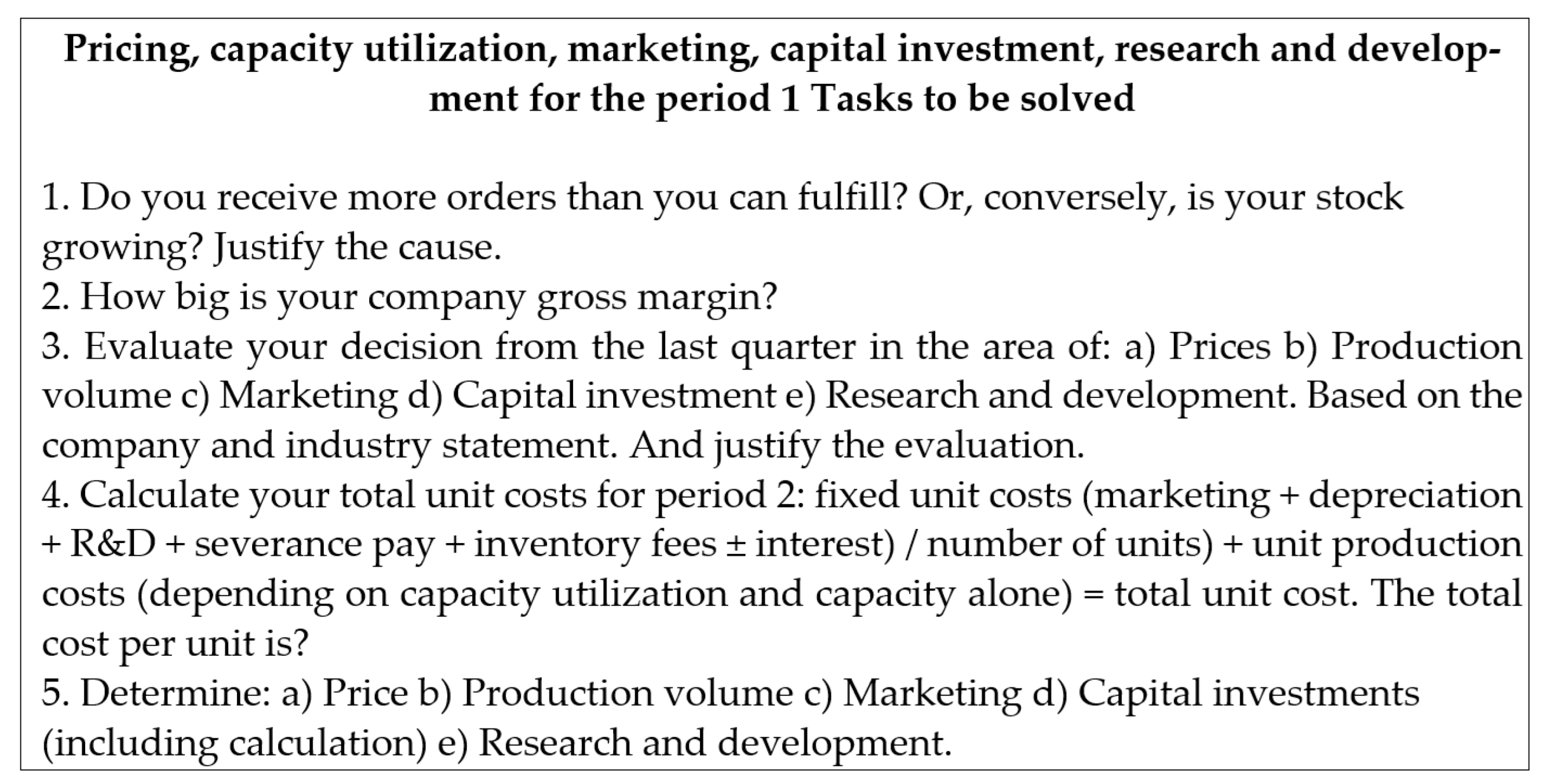
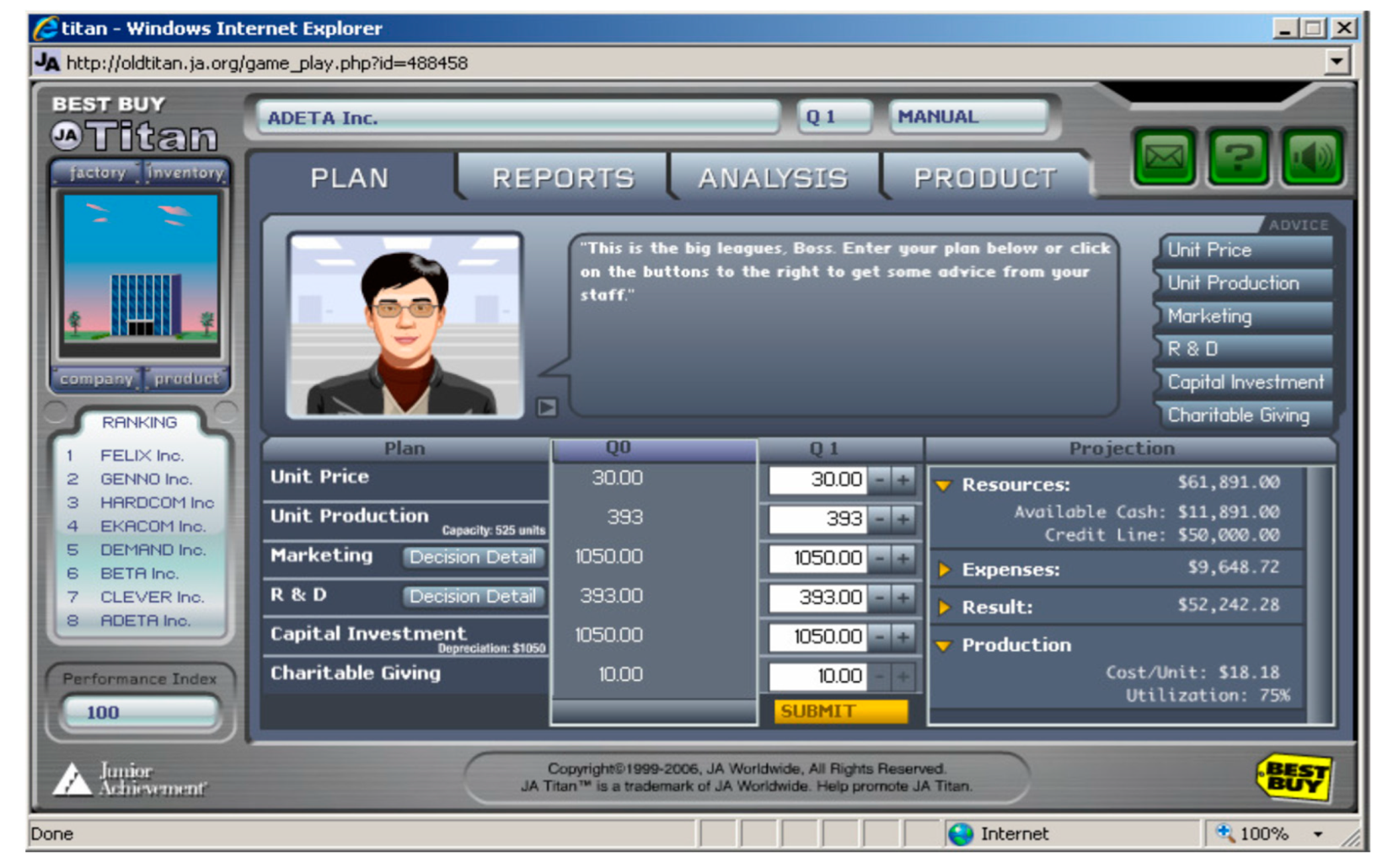
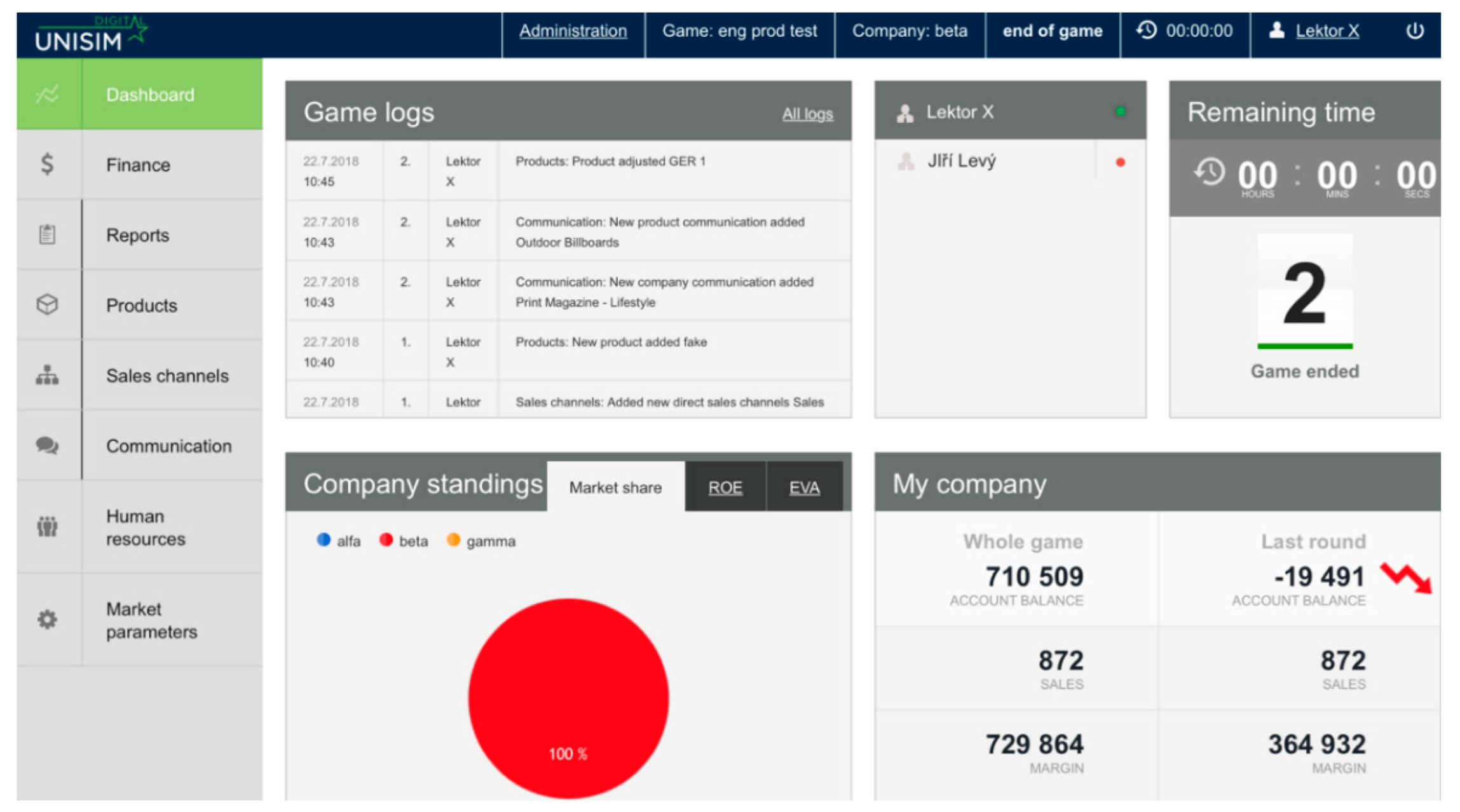
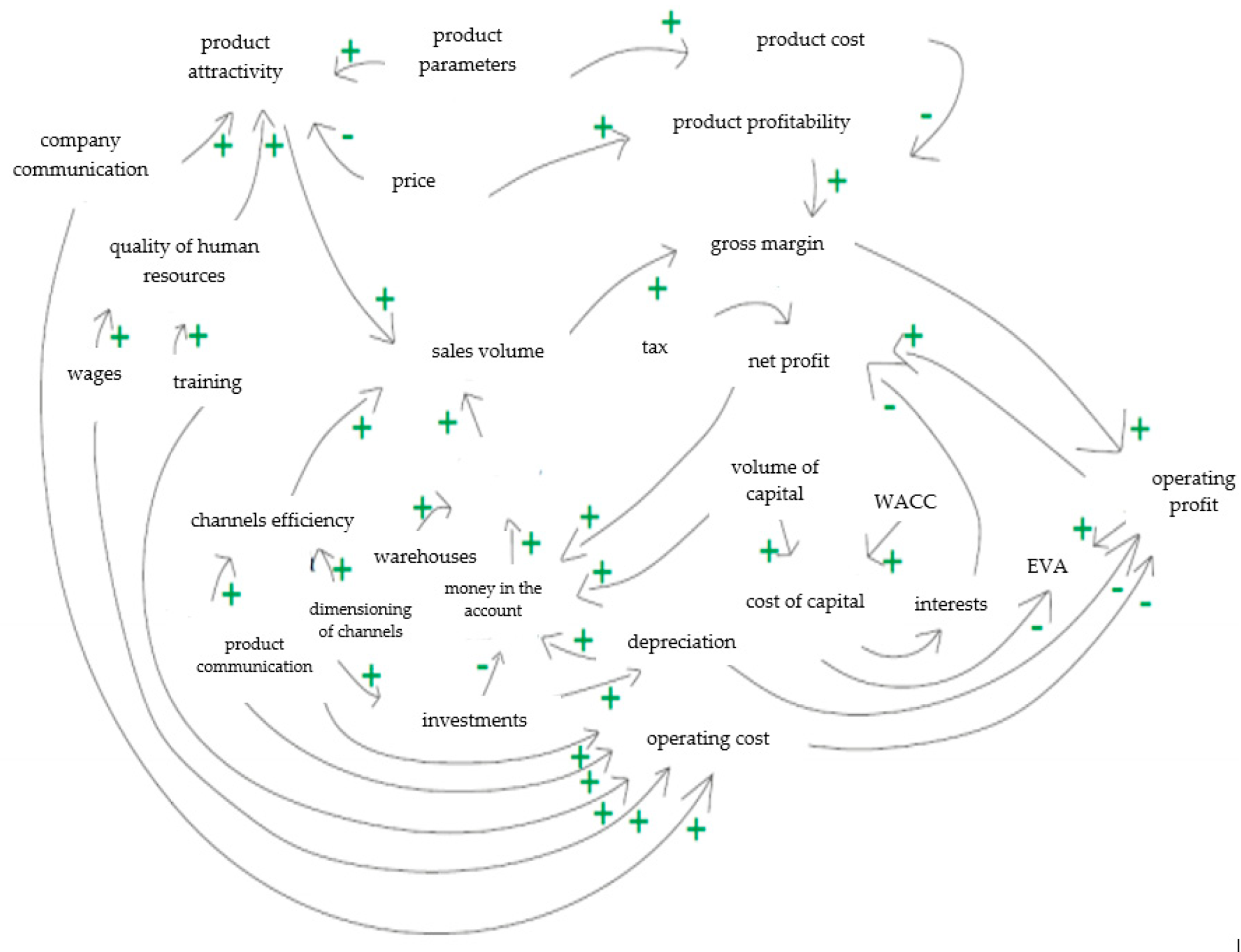
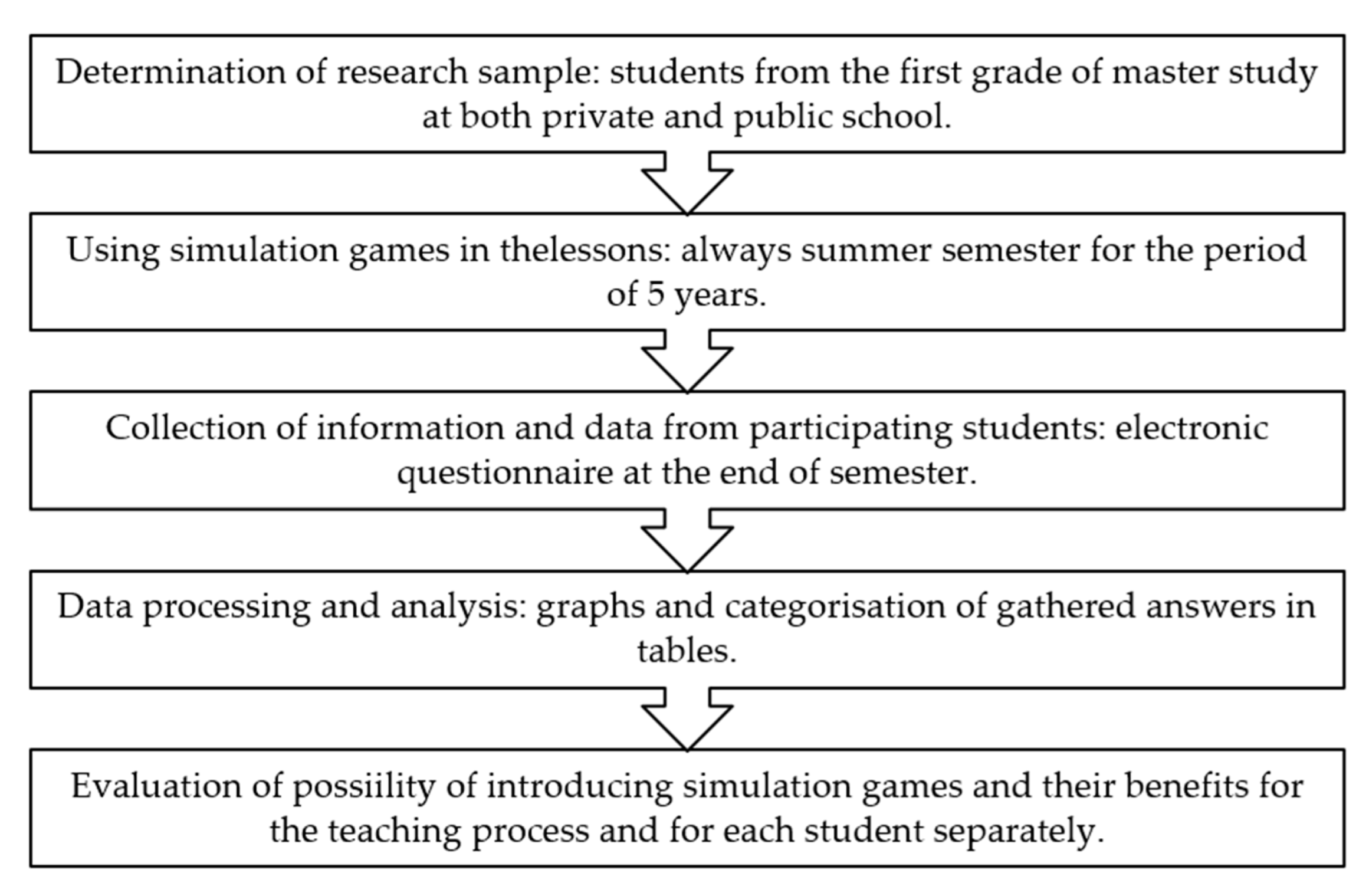

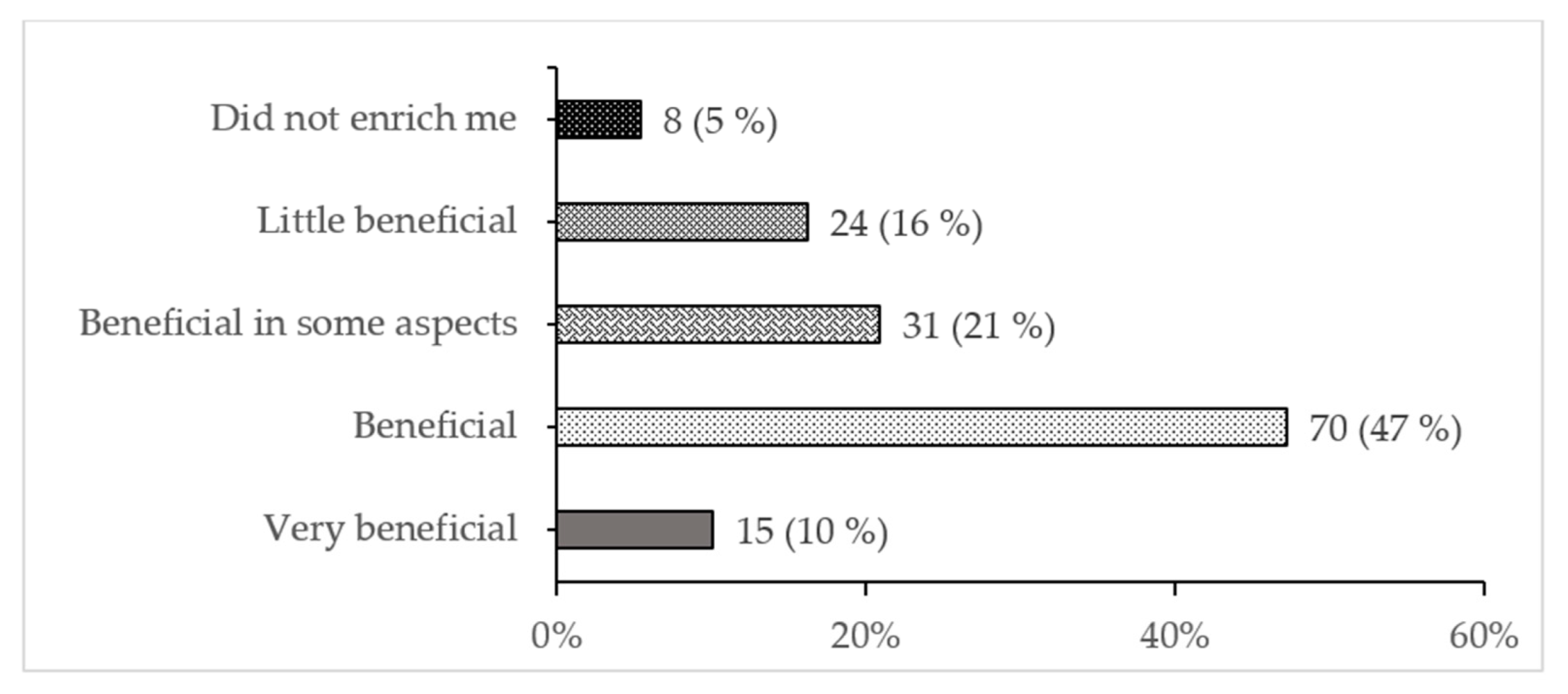
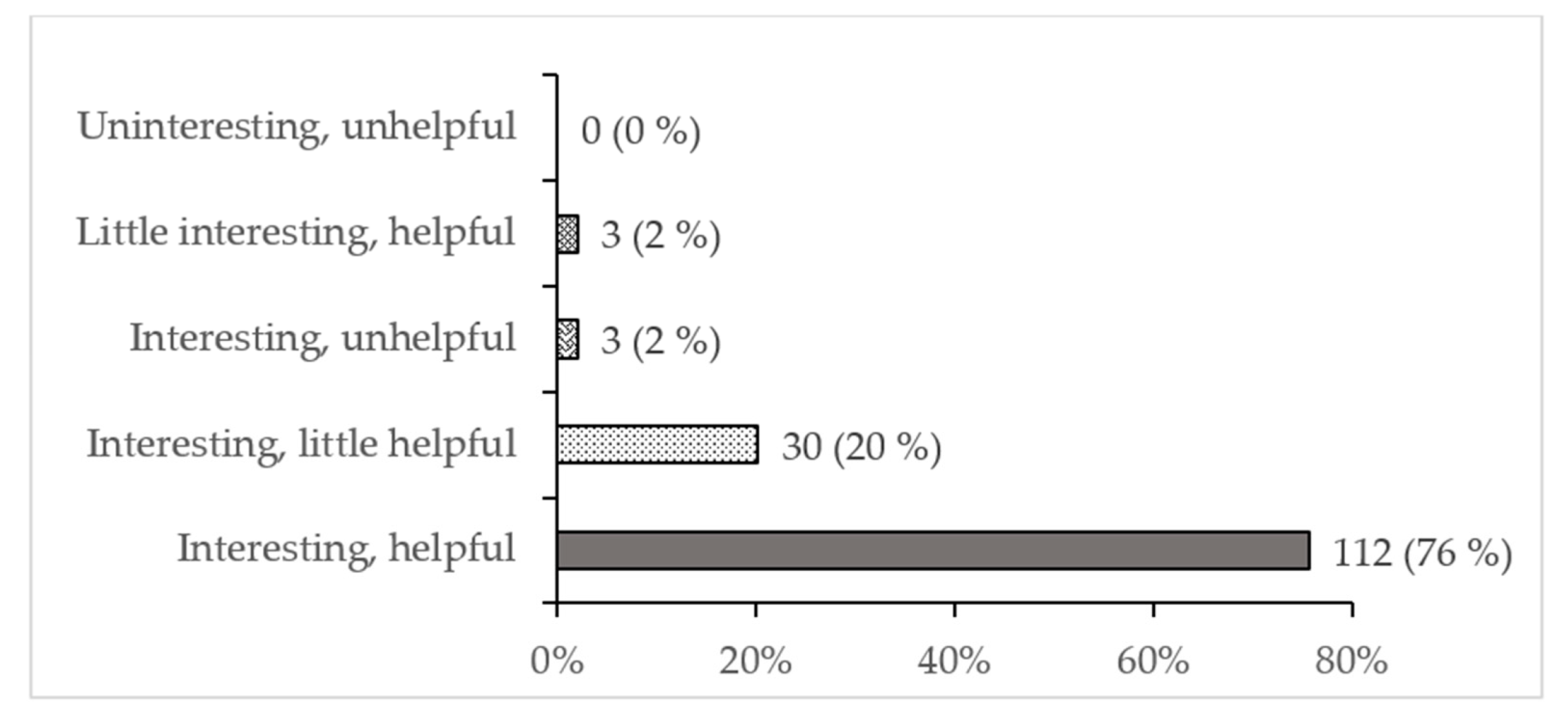

| Factors of PI Index | Weight |
|---|---|
| Total profit (profit from the beginning of the simulation) | 50% |
| Demand potential (the company’s share of total marketing and research and development expenses in the industry since the beginning of the period) | 10% |
| Supply potential (the company’s share of the total production capacity in the branch) | 10% |
| Productivity (firm efficiency) | 10% |
| Market share (the company’s market share in the current period) | 10% |
| Growth (by comparing the rate of company sales increase with the rate of increase in sales in the industry in the given period) | 10% |
| Simulated Area | Decision-Making Areas | Gained Experiences | Way of Measurement |
|---|---|---|---|
| Production, marketing, research and development, investment | Price, production, marketing expenses, research and development expenses, capital investment expenses, charity expenses | Experience in managing a production company, e.g., setting the production price and margin, production with regard to the use of production capacity, investment expenditures and the sale of stocks, orientation in financial statements, team communication | PI index |
| Simulated Area | Parameters of Decision-Making | Gained Experiences | Way of Measurement |
|---|---|---|---|
| Sales, product parameters, marketing, finance, human resources | Product parameters, price and quantity offered, communication tools to support the brand and sales, sales channels and their distribution and numbers in the regions, financing the company from its internal and external sources, remuneration, and employee training | Experience in managing a sales company with a focus on market segmentation, setting tools for communication mix, sales channels and human resources management, decision-making on financing expenses from own or external sources, orientation in financial statements and market research, team communication | Economic value added (EVA) |
| Group 1: Managerial Experience | Frequency: 32 |
|---|---|
| Opportunity to practice how a company can behave in the market and how to respond to competition. | |
| Experience with real company management and subsequent competition with competing companies. | |
| Changing the perception of the managerial position, experience with the game JA TITAN—finding out that I can’t think strategically. | |
| The game allowed me to put myself in the real situation of a manager who has to deal with fundamental steps that will affect the further course of the company in the future. | |
| Learn to navigate the market in different scenarios. | |
| The opportunity to test first-hand how the basic processes work in the company. | |
| Group 2: Understanding the Dependence between Economic Variables | Frequency: 22 |
|---|---|
| I have learned to perceive better the connections between different economic variables. | |
| Linking relationships between concepts such as price, cost and investment. | |
| I am acquainted with the dependence of selected economic variables related to business economics. | |
| I see the greatest benefit in gaining an overview of the dependencies of economic variables. | |
| Use of economic variables in practice. Simulation of price setting in comparison with the competition. | |
| Group 3: Teamwork | Frequency: 14 |
|---|---|
| Working in pairs and making compromises. | |
| Strengthening the ability to work in a team. | |
| I have learned to communicate sensibly with my colleague and we no longer argue. | |
| A test of team play, opinion strength, and the art of asserting myself in a team. | |
| It supports teamwork. | |
| Group 4: Business Inspiration | Frequency: 18 |
|---|---|
| Try different situations that could arise if we start a business. | |
| I could simulate a situation where I decided to do business. | |
| I see the biggest benefit in the fact that based on MSG I learned how certain ties work in a company. So, if at some point in my life I decided to do business myself or be in a job that would deal with this issue, then I already know what to focus on and I would pay attention to certain links that I learned in the simulations. | |
| Knowledge of the practical side of my own company. | |
| I began to think realistically: what it would be like to have my own business. | |
| Group 5: Game and Connection of Theory with Practice | Frequency: 11 |
|---|---|
| Learning through play, recognizing of the consequences of decisions. | |
| I see the greatest benefit in connecting practice in the form of playing a game with theory. | |
| Education in the form of a play (game). | |
| The game amused me quite a bit, I had a lot of fun. | |
| It was funny. | |
| Group 6: Analytical Skills and Orientation in Financial Statements | Frequency: 10 |
|---|---|
| Make quick decisions, work with documents in a foreign language. | |
| The ability to make decisions based on given data and to analyze decisions that have changed over time. | |
| I consider the greatest benefit to be better orientation in the financial statements. | |
| Ability to analyze economic data and make decisions on this basis. At the same time find out the reactions of various quantities. | |
| Understanding economic indicators on a practical example. | |
| Group | Frequency |
|---|---|
| Group 1: managerial experience | Frequency: 32 |
| Group 2: understanding the dependence between economic variables | Frequency: 22 |
| Group 3: teamwork | Frequency: 14 |
| Group 4: business inspiration | Frequency: 18 |
| Group 5: game and connection of theory with practise | Frequency: 11 |
| Group 6: analytical skills and orientation in financial statements | Frequency: 10 |
Publisher’s Note: MDPI stays neutral with regard to jurisdictional claims in published maps and institutional affiliations. |
© 2022 by the authors. Licensee MDPI, Basel, Switzerland. This article is an open access article distributed under the terms and conditions of the Creative Commons Attribution (CC BY) license (https://creativecommons.org/licenses/by/4.0/).
Share and Cite
Peterková, J.; Repaská, Z.; Prachařová, L. Best Practice of Using Digital Business Simulation Games in Business Education. Sustainability 2022, 14, 8987. https://doi.org/10.3390/su14158987
Peterková J, Repaská Z, Prachařová L. Best Practice of Using Digital Business Simulation Games in Business Education. Sustainability. 2022; 14(15):8987. https://doi.org/10.3390/su14158987
Chicago/Turabian StylePeterková, Jindra, Zuzana Repaská, and Lenka Prachařová. 2022. "Best Practice of Using Digital Business Simulation Games in Business Education" Sustainability 14, no. 15: 8987. https://doi.org/10.3390/su14158987
APA StylePeterková, J., Repaská, Z., & Prachařová, L. (2022). Best Practice of Using Digital Business Simulation Games in Business Education. Sustainability, 14(15), 8987. https://doi.org/10.3390/su14158987






